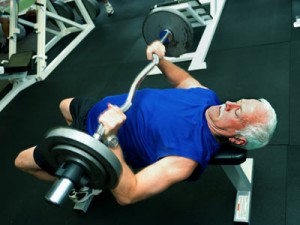 How Much, How Often
How Much, How Often
Build up your endurance gradually, starting out with as little as 5 minutes of endurance activities at a time, if you need to. Starting out at a lower level of effort and working your way up gradually is especially important if you have been inactive for a long time. It may take months to go from a very long-standing sedentary lifestyle to doing some of the activities suggested in this section. Your goal is to work your way up, eventually, to a moderate- to-vigorous level that increases your breathing and heart rate. It should feel somewhat hard to you.
Once you reach your goal, you can divide your exercise into sessions of no less than 10 minutes at a time, if you want to, as long as they add up to a total of at least 30 minutes at the end of the day. Doing less than 10 minutes at a time won’t give you the desired cardiovascular and respiratory system benefits. (The exception to this guideline is when you have first made the decision to begin doing endurance activities, and you are just starting out). Your goal is to build up to a total of at least 30 minutes of endurance exercise on most or all days of the week. More often is better, and every day is best.
Safety
Endurance activities should not make you breathe so hard that you can’t talk. They should not cause dizziness or chest pain. Do a little light activity before and after your endurance exercise session, to warm up and cool down (example: easy walking). Stretch after your endurance activities, when your muscles are warm.
As you get older, your body may become less likely to trigger the urge to drink when you need water. In other words, you may need water, but you won’t feel thirsty. Be sure to drink fluids when you are doing any activity that makes you lose fluid through sweat. The rule-of-thumb is that, by the time you notice you are thirsty, you are already some-what dehydrated (low on fluid). This guideline is important year-round, but is especially important in hot weather, when dehydration is more likely. If your doctor has asked you to limit your fluids, be sure to check with him or her before increasing the amount of fluid you drink while exercising. Congestive heart failure and kidney disease are examples of chronic diseases that often require fluid restriction.
Older adults can be affected by heat and cold more than other adults can. In extreme cases, exposure to too much heat can cause heat stroke, and exposure to very cold temperatures can lead to hypothermia (a dangerous drop in body temperature). If you are exercising outdoors, dress in layers so you can add or remove clothes as needed. Use safety equipment to prevent injuries. For example, wear a helmet for bicycling, and wear protective equipment for activities like skiing and skating. If you walk or jog, wear stable shoes made for that purpose. Endurance activities should not make you breathe so hard that you can’t talk.
Progressing
When you are ready to progress, build up the amount of time you spend doing endurance activities first; then build up the difficulty of your activities later. Example: First, gradually increase your time to 30 minutes over several days to weeks (or even months, depending on your condition) by walking longer distances, then start walking up steeper hills or walking more briskly. Even very small changes in muscle size can make a big difference in strength, especially in people who already have lost a lot of muscle. An increase in muscle that’s not even visible to the eye can be all it takes to improve your ability to do things like get up from a chair or climb stairs. Your muscles are active even when you are sleeping. Their cells are still doing the routine activities they need to do to stay alive. This work is called metabolism, and it uses up calories. That can help keep your weight in check, even when you are asleep!
Post Footer automatically generated by Add Post Footer Plugin for wordpress.